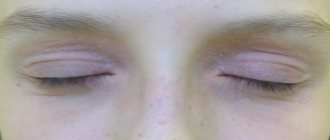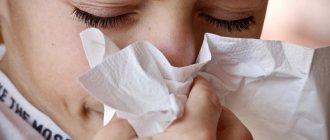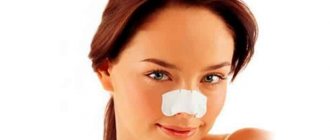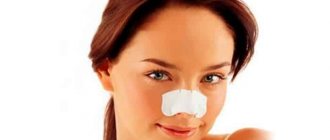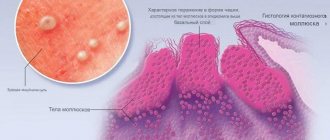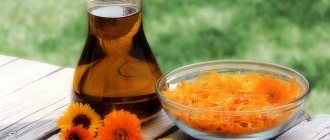Quick transition Treatment of cutaneous lupus erythematosus
Systemic lupus erythematosus is treated by a rheumatologist. During therapy with antimalarial drugs (hydroxychloroquine, chloroquine), observation by an ophthalmologist is necessary. If you suspect the development of squamous cell skin cancer against the background of discoid lupus erythematosus, consultation with an oncologist is necessary.
Lupus erythematosus rashes on the skin and/or mucous membranes can be an independent disease or a manifestation of systemic lupus erythematosus, a chronic disease associated with the formation of antibodies to components of cell nuclei. Antibodies cause damage and inflammation of various tissues, including the skin.
Causes and etiology
Redness around the nose: the causes usually correspond to dermatological diseases of the skin. In medical practice, women most often suffer from changes in skin color in this part of the face. At risk are teenagers during puberty and women who abuse the use of cosmetics.
Pathological condition of the epidermis: peeling in the nasolabial part of the face, redness caused by a number of negative factors. It is necessary to analyze each possible case in more detail.
Rosacea: symptoms
Rosacea is a long-term reddened condition of the facial skin. Additional signs: superficial vasodilatation, papules, pustules and swelling. Symptoms characterizing this disease:
- facial hyperemia – increased blood flow. A person may feel sudden rushes of blood (short and fast). The skin on the face turns pink, there is a feeling of warmth on it;
- redness on the nose, its sides and partly on the cheeks;
- the nose swells;
- red large pimples;
- cystic acne may appear;
- oily skin on the forehead;
- dryness, itching in the eyes - in some cases.
The appearance of acne is often caused by hyperemia. It is this disease that aggravates rosacea and turns the problem into a chronic one. First, the tip of the nose acquires a reddish tint, and the pigmentation spreads to the bridge of the nose. As soft tissue grows, the nose becomes slightly enlarged and deformed. This disease is most often diagnosed in women who are postmenopausal.
Negative factors that provoke this condition:
- eating spicy food;
- alcohol abuse;
- face mite infestation;
- intestinal infections.
Rosacea is not dangerous, but it brings aesthetic and psychological discomfort.
Symptoms
The skin manifestations of lupus erythematosus are diverse. A significant manifestation, almost always associated with a systemic disease, is a rash on the face, shaped like a butterfly: with wings on the cheekbones and cheeks and a body on the bridge of the nose and bridge of the nose. The rash may appear as raised or deep-lying elements of pink and bluish-red color. There is a tendency to form ring-shaped lesions covered with very dense scales that are painful when removed. In some cases, the so-called lupus erythematosus pernio is formed, in which painful bright red bluish nodules appear on the toes, hands, nose, and ears in cold weather. Damage to blood vessels is accompanied by the appearance of rashes resembling bruises; dilated vessels can be visible in the nail beds. Some patients with SLE have symptoms resembling lichen planus.
There are also severe lesions with the formation of blisters and peeling of the skin, which is more typical for the onset of a systemic disease. Changes can affect the mucous membranes, especially often the mucous membranes of the lips and oral cavity. Lupus lesions on the scalp may result in hair loss. Diffuse hair loss and hair thinning are also possible.
Perioral dermatitis
Redness of the skin around the nose and under the eyes in the form of red pimples and peeling are symptoms of perioral dermatitis. This disease manifests itself in the form of eczema. It mainly affects the mouth and lips area. Among the causes of occurrence are the following:
- long-term use of nasal sprays, creams containing topical steroids;
- the use of cosmetics based on petroleum jelly or paraffin;
- certain types of toothpastes;
- bacterial and fungal infections.
Symptoms of perioral dermatitis:
- a red rash on the sides of the nose, in the folds under the nose and eyes, also on the chin and forehead;
- in severe cases, the rash manifests itself in the form of peeling on inflamed areas of the skin;
- burning and constant itching.
The disease can appear at any age, regardless of gender and race. Young women and teenagers are most often affected.
Experts in the field of dermatology say that recurrence of perioral dermatitis can cause chronic rosacea.
Causes of peeling skin in the nose area
Dermatological specialists identify a number of reasons that cause this unpleasant symptom.
Allergy
Very often, redness of the skin is caused by an allergic reaction of the body. Typically, this causes itching, the skin begins to peel, and you begin to sneeze. The reason for this may be food or certain components of cosmetics. To overcome allergies, you will need to undergo a course of treatment, which should be prescribed by an experienced allergist. He will determine what exactly causes this reaction in the body and prescribe proper treatment. On your part, you need to exclude from your diet fatty, spicy, heavily fried and smoked foods, as well as semi-finished and instant foods. Try to eat only healthy foods and drink clean, non-carbonated water.
Avitaminosis
If the skin peels not only around the nose, but throughout the body, then this may be caused by vitamin deficiency. As a rule, it occurs in the spring, when the body is weakened and has a lower threshold of resistance to negative environmental factors. The body exhibits a sharp deficiency of vitamins and essential minerals. This problem can arise due to unfavorable environmental conditions, smoking, drinking alcohol and leading a sedentary lifestyle. The body becomes weak and susceptible to all sorts of diseases. The lack of vitamins A and C leads to the fact that the skin becomes fragile, and a low intake of vitamin E worsens the water balance, which leads to dry skin.
How to treat a weakened body? Regular intake of a vitamin complex can improve this condition. Experts also recommend increasing the amount of consumption of the following products in your diet:
- fatty fish;
- liver;
- boiled meat;
- butter;
- chicken egg yolks;
- greenery;
- fresh fruits and vegetables
To treat vitamin deficiency, you should give up bad habits, lead an active lifestyle, take daily walks and drink 2 liters of water a day. From late autumn to spring, you can drink a rosehip decoction, which will saturate the body with vitamins.
Runny nose
If the wings of your nose are peeling, this may be the cause of a lingering runny nose. Accumulating mucus creates irritation of the epidermis, and since you try to constantly remove it, redness and micro-wounds appear.
Failure to comply with basic care
If the skin around your nose, cheeks and forehead, as well as around your mouth peels, this may indicate that you are using the wrong soap, milk, face cream, gel or foam. This may be caused by the body's reaction to components of cosmetic products that do not moisturize the skin, but rather dry it out. Therefore, it is recommended to use cosmetics from trusted companies. They should contain the necessary fats and vegetable oils that moisturize the skin and nourish it with minerals and trace elements. It is best to entrust the selection of cosmetic products to a specialist - a dermatologist or cosmetologist.
External factors
Very low or high temperatures can also affect the overall health of the skin. If the skin on the bridge of the nose and around the nose is peeling, this may be caused by exposure to very low temperatures. If it is severely frosty outside, it is recommended to lubricate your skin with protective cream before going out. It must be selected according to your skin type. At least 20 minutes before going out, apply it to the skin and let it absorb. Chlorinated water can also cause skin irritation, so it is better to wash your face with clean well or settled water.
Skin disease
If you notice red spots, the skin begins to itch and peel, this may be caused by a skin disease. In this case, you need to visit a good dermatologist. After the test and examination, the doctor will prescribe the correct treatment. The nose and area around it may also peel from infection with skin parasites or when a fungal disease develops. It could be:
- seborrheic dermatitis;
- seborrheic psoriasis;
- eczema.
These serious diseases can be caused by increased oiliness of the skin, unbalanced and unhealthy diet, stress, hormonal imbalance and nervous strain.
Seborrheic dermatitis
Redness and flaking of the facial skin around the nose are sure symptomatic signs of seborrheic dermatitis. The disease manifests itself on the face, around the nose, around the eyes, on the forehead and affects the scalp. Seborrheic dermatitis is a chronic disease, but is not transmitted.
Seborrheic dermatitis is caused by yeast-like fungi. This is a disease of the sebaceous glands. Thus, when exposed to chemical, physical, mechanical and thermal irritants, with a decrease in immunity, the activation of fungi is provoked. They multiply and appear in significant numbers. The skin on the nose turns red and becomes covered with peculiar ulcers.
Why does the skin on my nose peel?
There are two types of causes of skin peeling: physiological and pathological. Among the most common are:
- Avitaminosis. A lack of vitamins D, C, A, PP, E, K, B can provoke peeling of the skin.
- Allergy to low-quality cosmetics. It is observed in people with sensitive skin types.
- Respiratory diseases. Due to a runny nose, a person is forced to frequently touch the nose area with a napkin or handkerchief, which can cause the skin to dry out. Also, the components of the drops can cause irritation.
- Environmental influence. Abnormal air temperatures, high or low, affect the condition of the skin.
- Incorrect facial care. Using products that do not match your skin type can cause dryness of the upper layer of the epithelium.
- Hormonal changes. Increased levels of the stress hormone (cortisol) lead to peeling of the facial skin.
- Salon procedures. Techniques such as ultrasonic, mechanical or combined facial cleansing cause peeling of the skin for 5 days.
The skin on the nose can peel off for pathological reasons:
- Fungus (candidiasis, rubromycosis, pityriasis versicolor, microsporia, trichophytosis, seborrheic dermatitis). The latter is caused by the yeast-like fungus Malassezia, the causative agents of the others are Trichophyton, Microsporum, Candida.
- Dermatitis of another etiology (perioral). It occurs due to long-term use of corticosteroids.
- Acne (blackheads). This inflammatory skin condition causes excess sebum production, causing clogged pores and resulting in flaking of cells.
- Systemic lupus erythematosus. The human body begins to fight with its own cells. The disease occurs due to genetic characteristics and hormonal changes.
- Lupus pernio (lupus pernio). Accompanied by staining of the skin of the nose. Its exact causes are unknown, but genetic predisposition may play a role.
- Psoriasis. The disease occurs as a result of an immune response, and peeling occurs due to the accelerated rate of cell division.
- Periarteritis nodosa. It is a form of vasculitis affecting small arteries; the exact causes of its occurrence are unknown.
Depending on symptoms
When diagnosing the condition, the dermatologist pays attention to the accompanying symptoms. Along with peeling, the following may appear:
- red spots, itching, ulcers - demodicosis;
- irritation - seborrheic dermatitis;
- redness - hyperemia of the skin;
- itching, tightness, red spots similar to pimples - fungal infection;
- pain, cracks - eczema;
- rash, tingling, dry skin - allergies.
Depending on location
The area of peeling can tell more about why this skin defect appears. Depending on the local location of the deficiency, the following causes of its occurrence are distinguished:
- around the nose and mouth - vitamin B deficiency;
- on the forehead and around the nose - dermatitis;
- scalp, forehead and nose - inflammation in the lower layer of the epidermis;
- on the chin and nose - diseases of the digestive system;
- under the nose, on the wings of the nose and around the nostrils - previous acute respiratory infections, the use of sprays and drops for a runny nose;
- on the sides - rosacea (a skin condition accompanied by superficial dilatation of blood vessels, swelling, papules, pustules);
- bridge of the nose - allergic reaction.
Demodicosis
This is a fairly rare dermatological disease. Demodectic mange is caused by a subcutaneous parasitic mite. Experts believe that 97% of the inhabitants of planet Earth have such microorganisms. However, their manifestation is caused by decreased immunity, a severe emotional state and great stress experienced.
Demodicosis occurs in pregnant women and those who suffer from hormonal diseases. Without special equipment, it is impossible to identify the subcutaneous parasite.
Allergic reaction
Dust, mites, seasonal flowering of certain plants, animal hair, cosmetics are the reasons that cause redness of the facial skin around the nose. This is all an allergic reaction of the human body to external irritants.
The mucous part becomes inflamed due to hyperemia (dilation of the capillaries), and severe swelling of the skin occurs. Redness of the nose is one of the symptoms.
Frequent use of a handkerchief can cause skin irritation.
Lupus pernio: what kind of disease, symptoms and causes
Redness on the face around the nose is a form of manifestation of lupus pernio. This is a form of cutaneous sarcoidosis. The color change occurs due to an increase in the vascular network. The color of the redness can vary from a reddish tint to purple. Changes in skin color can affect not only the nose area, but also the cheeks, lips and ears. At the same time, the skin in the inflamed areas shines and swells.
The disease most often affects women between 45 and 65 years of age.
Symptoms of lupus pernio are not clearly visible. There may be slight itching or pain when pressed. Cosmetic external disfigurement is a common complaint. The cause of the disease is still unclear.
Systemic lupus erythematosus
Lupus is an autoimmune disease. In this disease, the immune system mistakenly attacks healthy tissue.
Symptomatic manifestations of the disease can begin in adolescence and up to 30 years.
Redness around the nose, fatigue, fever, dry mouth, and joint problems are common symptoms of lupus.
The skin rash on the face resembles the shape of a butterfly. This is why it is popularly called “butterfly rash.” However, a rash is not always characteristic of the manifestation of this disease.
Causes of red, scaly spots
Response to environmental factors. This problem often occurs among those with dry skin: with prolonged exposure to cold, strong wind, or exposure to the sun, the face begins to peel and become covered with spots.
Avitaminosis. If there is a lack of certain vitamins in the body (A, C, P), the skin becomes dry, irritated, and spots often appear on it. Usually in this case, red spots appear in the spring.
Demodecosis. This is a disease caused by a subcutaneous mite.
Rosacea. This is an inflammatory skin disease (chronic), which causes red spots and purple pimples to appear on the face. They abundantly cover the cheeks, chin and nose. The cause of rosacea is unknown.
Acne. When acne (blackheads) appears, red spots appear on the face with a raised area in their center. Most often, acne occurs during hormonal disorders, including adolescence, menopause, and pregnancy.
Nerve spots. In some people, when they are very nervous, their face, neck, and upper chest become covered with red spots.
Helminthiasis. Redness on the face also occurs due to the presence of parasites in the body.
CPAP mask
People suffering from acne or sleep apnea often resort to using a CPAP mask. This is special equipment. Due to the strong tension of the belts, redness around the nose occurs almost immediately. Using this mask may cause serious inflammatory skin disease. Ulcers may appear on the skin of the face.
Solution to the problem: choose an alternative method of acne treatment.
Rosacea
Rosacea is a chronic skin condition that can cause redness, redness, and visible blood vessels. It is not uncommon, but there is currently no cure for it.
Erythematotelangiectatic (ETH) rosacea and rosacea are subtypes of the condition that can cause rashes and redness around the nose.
How to treat redness
Redness from rosacea is treated differently than redness caused by other conditions.
Avoid the ingredients witch hazel and menthol, which are found in many toners and other exfoliating products.
Prescription topical ointments can be used to treat redness. Laser treatment is also an excellent treatment option for persistent facial redness due to rosacea.
Lifestyle recommendations
People with rosacea usually need to figure out what's causing their symptoms to reduce the frequency of flare-ups.
Common triggers include spicy foods, alcoholic drinks, and prolonged sun exposure.
People with rosacea should also wear a high SPF sunscreen or a physical blocker such as zinc oxide, as well as sun-protective clothing.
Other reasons
Other reasons can cause redness and peeling of the skin around the nose:
- abuse of drugs that affect the cardiovascular system;
- ARVI is a respiratory infection of viral origin, acute rhinitis is a clear symptom;
- rhinophyma - benign tumor-like skin lesion;
- acne vulgaris, a manifestation of hormonal imbalance, chronic endocrine pathology and improper facial skin care;
- avitaminosis;
- psychoneurological abnormalities - stressful situations, anxiety contribute to the dilation of blood vessels on the skin of the face, blood microcirculation is disrupted;
- formation of subcutaneous acne;
- single pimples;
- cuts or scratches;
- burns;
- long walks in the cold.
What to do
- Regularly apply a product with a moisturizing and soothing effect to the skin.
- Start taking vitamins and medications that strengthen the immune system.
- In case of allergies, it is necessary to identify the allergen, try to exclude or minimize contact with it and take antihistamines.
- To get rid of the symptoms of demodicosis, complex treatment is used, including taking vitamins, local treatment with ointments, and diet.
- In some situations, a dermatologist prescribes professional facial cleansing.
- It is advisable to turn to treatment with homeopathic remedies that affect the entire human body, and not just eliminate visible problems.
When to see a doctor?
Redness around the nose is a symptom of various pathologies. If your nose remains red for a long time, you should consult a dermatologist. Diagnosis of the disease includes a general blood and urine test, biochemical blood test and others.
Additional symptoms should cause severe anxiety in a person:
- chills, deterioration of health, fever;
- purulent discharge on the nose;
- the appearance of painless formations on the walls, back and wings of the nose;
- the skin on the nose thickens, and the nose visually increases in size.
You should not prescribe treatment on your own. You should immediately consult a doctor without neglecting the symptoms.
Methods for getting rid of flaking skin on the nose
If the skin under your nose is peeling, there is no need to let the situation take its course. Firstly, this is an ugly phenomenon, and secondly, be sure to understand the reasons for its occurrence. Without doing this, you will only be able to get rid of the anomaly for a short period of time, but the main problem will still remain.
So, what to do if your nose is peeling? To do this, follow simple rules for the safe removal of dead skin.
- Never scrape dead skin cells dry to avoid infection. Before this procedure, the epidermis should be well moistened with water and then with a rich cream. Only after this, using a soft cloth or cotton pad, can you begin manipulation.
- After the skin that peels off on the wings of the nose or around it is removed, you need to wipe your face with an antiseptic (you can use a decoction of chamomile or calendula for this), and then apply a moisturizer to it. It is better to choose a product that is based on natural ingredients (extracts of medicinal herbs, healthy fruits, flowers, etc.).
Now we should consider in more detail the question of what to do if the skin on the nose often peels off. Removing it using the above-described manipulations every time is not the best option. It's easier to prevent it from starting to peel off.
- Use only high-quality cosmetics that fully match your facial skin type. Avoid using antibacterial soap, which dries and depletes the epidermis.
- Get examined by a doctor in a timely manner for dermatological and endocrine diseases. Heal them completely to avoid serious consequences, including for facial skin.
- Wash with soft water. If tap water is too hard, use filters to settle it. This will help avoid irritation of the epidermis, leading to peeling of the skin on the nose.
- Drink enough fluids. It is necessary not only for the normal functioning of the kidneys, but also for moisturizing the epidermis.
- Avoid sudden changes in temperature.
- During the hot season, always apply a protective cream to your facial skin to prevent it from getting “burned” and starting to peel off.
If the skin near the nose and eyebrows is peeling, you can try applying masks made from natural ingredients to these areas of the face. Several such recipes are presented below.
https://youtube.com/watch?v=dAby5kNHdt4
Curd and oil mask
If the skin on the bridge of the nose, wings of the nose or around it is peeling, this cosmetic product will cope with the problem perfectly. To prepare it, you need to take 5 g of low-fat cottage cheese (it is better if it is homemade), as well as 1 teaspoon of olive oil and fresh, finely chopped parsley. Mix the components and distribute evenly over the epidermis of the nose, as well as onto the areas around it.
After a quarter of an hour, carefully wipe the mask with a soft cloth or cotton pad soaked in a decoction of chamomile or calendula.
Mask with linden decoction (infusion)
Mix linden decoction or infusion, oatmeal and olive oil in equal proportions. Mix until smooth and apply to problem areas of the nose. The mask can also be used to get rid of roughness of the epidermis and its cracking on other parts of the face.
Leave the product on for 7-13 minutes, then remove lightly with warm water.
In order not to think about the question of what to do if the skin on your nose is peeling, you can make the first and second mask (alternately) for prevention. At the same time, it is better to apply them not only to a specific area of the skin, but also throughout the entire face. Since such cosmetics are prepared exclusively from natural ingredients, they cannot cause harm to the skin.
Treatment
Redness around the nose is a manifestation of pathologies. Timely diagnosis and proper treatment are necessary. Traditional medicine includes the following drugs:
- to strengthen the walls of blood vessels, normalize blood pressure - tablets "Antistax", "Ascorutin", "Detralex";
- vitamin therapy to improve metabolic processes in the body: vitamins C, P and K;
- restoration of the immune system with the help of immunomodulators: “Immunal”, “Bronchomunal”, “Likopid”;
- special ointments containing antibiotics;
- physiotherapy;
- laser therapy, surgery for rhinophyma;
- antihistamines “Suprastin”, “Tavegil”;
- for respiratory infections, antiviral drugs are prescribed: Kagocel, Cycloferon;
- antibacterial and anti-inflammatory treatment (for seborrheic dermatitis and rosacea).
Systemic lupus erythematosus is treated only by rheumatologists. Patients are prescribed hormone therapy.
Natural Treatments
You can resort to traditional medicine only after consulting your doctor. If the doctor has not detected a serious pathology, then traditional methods of treatment can be used.
- A mask of lemon, honey and fresh parsley is an excellent remedy for redness around the nose and flaking. Parsley needs to be chopped and mixed with lemon juice and honey. Apply the mixture to your nose for 5 minutes.
- Every morning, treat your nose with an ice cube of chamomile infusion.
- Wipe the skin of the nose with hoofweed infusion.
- Fresh apple mask: grate an apple, add lemon juice. Apply the resulting product to the nose.
- Soak gauze in rosehip broth and place it on your nose.
Redness around the nose, peeling - external defects on the face. They should not be ignored. People suffering from this defect become irritable. Gradually, they may develop an inferiority complex. And this is already a psychological problem.
If the first symptoms appear, consult a doctor immediately. Perhaps pathology is already actively developing in your body. Self-medication is an ineffective way to deal with redness. The key to your health is timely traditional treatment. Your health is in your hands!
Good afternoon Since 2015, I have had a red spot on the bridge of my nose, near my left eye. It feels like skin renewal. I've been on treatment for 4 years now (Pimofukort, Comfo-Derm, Elidel, Flucinar), it seems to be starting to lighten, then it turns red again. I saw an oncologist and was diagnosed with basilioma, the result was negative. Now a dermatologist is diagnosing benign lymphoplasia of the skin. Appointment - elidel. I applied it for 2 weeks, it became a little pale, now it’s red again. Tell me what to do? Where to go, what to do? Maybe I need to try something with a laser?
The Ask a Doctor service offers an online consultation with a dermatologist on any problem that concerns you. Expert doctors provide consultations around the clock and free of charge. Ask your question and get an answer immediately!
1. Rectum. On the face it is represented by a projection zone on the surface of the skin of the upper left forehead. Functional impairment can manifest itself as skin pigmentation, acne, redness, and the growth of moles.
2. Sigmoid colon. Its representation is located on the surface of the skin of the left upper lateral area of the forehead. Functional impairment can manifest itself as skin pigmentation, pimples, redness, and moles.
3. Liver. The representation is located between the eyebrows, in the space between the base of the bridge of the nose and the line connecting the brow ridges on the skin of the forehead. Liver pathology is accompanied by skin irritation, acne, pigmentation, and moles.
4. Small intestine. Its projection is located in the middle part of the forehead, and with intestinal pathology it is manifested by skin disorders (pigments, pimples, redness).
5. Descending part of the colon. Its representation is located on the left lateral surface of the skin of the forehead. Functional disorders manifest themselves on the skin (pigmentation, dryness of the area, increased porosity, acne).
6. Left adrenal gland. The projection is located in the medial superciliary region of the left half of the face. With a functional disorder of the adrenal gland, pain in the periosteum of the superciliary region appears, and the skin reacts with irritation.
7. Area of the left kidney pelvis. It is projected onto the skin of the inner surface of the corner of the left eye and the tear duct. The pathological process in the area of the renal pelvis is sometimes expressed by a skin reaction in this area (darkening, pigmentation, redness, enlarged pores, growth of papillomas, wen). Sometimes the problem contributes to the formation of a blockage of the tear duct, an inflammatory process in it, and excessive lacrimation.
8. Upper pole of the left kidney. It is projected onto the brow ridge and the skin of the upper part of the eyelid. The disorder is manifested by a vascular pattern (swelling), pimples, redness, and porosity on the skin.
9. Left lobe of the liver. Projected onto the white membrane of the eye. A disorder in the liver is manifested by a red vascular pattern on the white of the eye.
10. Body of the gallbladder, spleen. The projection is located on the skin and on the periosteum of the temporal bone on the left side of the face. With bladder pathology, redness, pimples, pigment spots appear on the skin, its porosity and venous pattern increase. The periosteum of the temporal bone also reacts; it becomes painful upon palpation.
11. Left part of the transverse colon. The representation is located in the lower medial part of the corner of the left eye. Its dysfunction is manifested by bulging of the skin from the inner corner of the eye under the lower eyelid to the outside of the face, sometimes with redness or pigmentation.
12. Pancreas. Its representation is located on the lower part of the bridge of the nose, at the border of the connection with the tip of the nose. The pathology is manifested by skin irritation, pigmentation, and sometimes a venous vascular pattern.
Treatment methods
Etiotropic therapy consists of treating the root cause. Treatment of symptoms is necessary to reduce or remove severe symptoms not associated with internal disorders. Treatment tactics involve the use of not only medications, but also physiotherapeutic and caring procedures that protect the skin from external factors.
Redness on the face can be removed using the following products:
- keratolytic, which gently cleanse the skin, remove scales, and prevent further clogging of pores;
- anti-inflammatory, reducing existing inflammation;
- antibacterial;
- adsorbents.
Before using the products suggested in the table, you should consult a dermatologist. Resolving skin redness depends on the underlying cause, which needs to be determined.
| Effect of the drug | Name | Price in rub. |
| Anti-inflammatory | Advantan | 500 |
| Afloderm | 230 | |
| Elokom | 100 | |
| Keratolytic | Roaccutane | 1600 |
| Differin | 700 | |
| Belosalik | 200 | |
| Baziron | 600 | |
| Lorinden | 350 | |
| Antibacterial | Skinoren | 600 |
| Belogent | 130 | |
| Hyposol | 1100 | |
| Tea tree oil | 100 | |
| Absorbents | White clay | 30 |
The products used should not contain alcohol, so as not to dry and irritate the skin. It is better to select tonics based on juniper, chestnut, and hops.
Useful vitamins for facial skin:
- Vitamin D increases protective properties and regenerates the skin.
- Vitamin K, anticoagulant, helps with vascular defects, brightens the skin.
- Vitamin E, an antioxidant, restores damaged cell membranes.
- Vitamin A accelerates healing, supports collagen synthesis, and has a positive effect on the immune system.
- Vitamin C strengthens capillary walls and slows down skin aging.
When treating rosacea, heparin ointment helps well; the course of treatment should not exceed 1 week. Oxymetazoline cream and laser treatment help with rosacea.
Traditional methods
Products based on:
- witch hazel;
- mint;
- eucalyptus;
- carnations.
You can use masks based on green tea, turmeric, cucumber, and ginger.
Aloe pulp is good for soothing irritated skin:
- Remove the pulp from the core of the leaf and apply to your face.
- Perform the procedure 2 times a day
Mask based on coconut oil, a natural emollient product that retains moisture in the skin:
- Soak a swab in oil and wipe your face.
- Leave until dry, then rinse with warm water.
Oatmeal mask:
- Grind pure oats to flour, mix with milk or water.
- After the oats have absorbed all the liquid, apply the mixture to your face.
- The procedure can be carried out every day, applying the mask for 20 minutes.
Cucumber mask:
- Fresh cucumber, peeled, cut into discs.
- While lying down, place cucumber slices on your face. Keep for at least 20-25 minutes.
- It is not recommended to rub the pulp into the skin so as not to cause irritation.
Green tea lotion:
- Brew green tea. Let it brew.
- After brewing, while the drink is still warm, pour the tea into a wide bowl and soak a cotton napkin in it.
- After wrung out the fabric, apply it to your face and leave for 10-15 minutes.
- You should not actively rub tea into the skin so as not to irritate it.
Other methods
Redness on the face can be removed with peeling. For irritated skin, it should be gentle, properly regulating the exfoliation of the surface layer.
- Glycolic peeling. The glycolic acid molecule is very small, so it quickly penetrates the epidermis without causing irritation.
- Lactic. Lactic acid whitens the skin, brightens and strengthens the walls of blood vessels.
- Peeling with retinolic acid. This is the most superficial, gentle peeling that is gentle on the skin.
To strengthen blood vessels, we can recommend PQ Age peeling based on trichloroacetic acid. After it, a whitening, rejuvenating effect is created with minimal exfoliation.
Electroporation sessions with glycolic acid will help restore the functioning of capillaries and epidermal cells.
For hormonal disorders that occur during menopause, you should strengthen the immune system, do yoga, exercise, and massage. To strengthen the nervous system, take antidepressants: Paroxetine, Venlafaxine. The proposed techniques will reduce the wave of “hot flashes” that affect the redness of the face.
